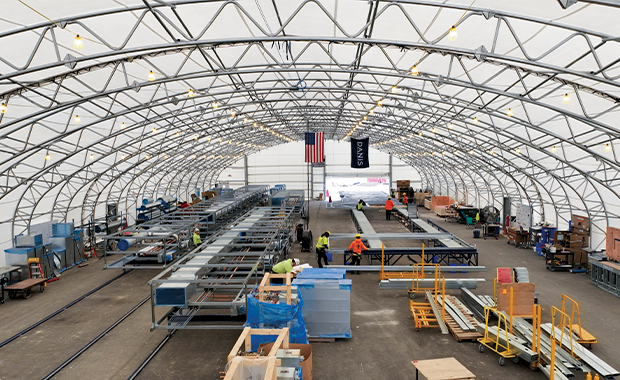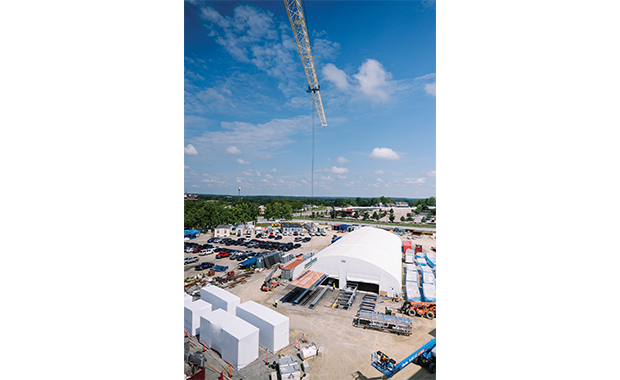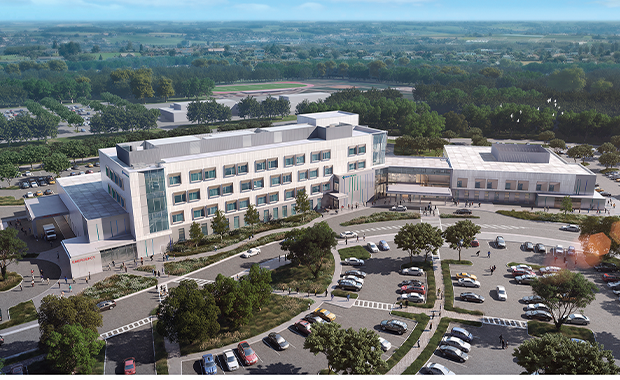Bon Secours Mercy Health Takes Prefabrication To The Next Level
This article was originally published on July 25, 2023, and is among Healthcare Design’s most-read articles of 2023. To see a full list, click here.
In early 2021, Bon Secours Mercy Health announced plans to build Mercy Health Kings Mills, a 60-bed hospital and medical office building in Mason, Ohio—the system’s first new hospital in the Greater Cincinnati area since 2014.
During the request for proposals process, Molly Ironmonger, director of system planning and preconstruction at Bon Secours Mercy Health (Cincinnati), says she challenged contractors to demonstrate “creative problem solving” to meet the ministry goals to deliver the project faster, safer, and more cost effectively than the organization had done in the past.
“My job is not to prescribe how to do something,” she says. “We were saying, ‘These are our problems. Come solve them.’”
This push for new strategies was a response to the continued challenges the organization and many others are facing tied to construction labor shortages, supply chain disruption, and materials pricing escalations.
“As somebody sitting in my seat inside a healthcare organization, if you aren’t working on conversations around how to improve and change how you’re delivering projects, you’re really missing opportunities, because how you’ve always done it is not going to be possible,” she says.
Prefabrication in healthcare design
Prefabrication is one strategy being used to help address these challenges. In fact, several of the firms interviewing for the general contractor role on the 206,000-square-feet Kings Mills project proposed prefabrication, taking the traditional approach whereby building components are made in another location, stored, and then transported to the final site for just-in-time delivery.
However, Danis had another idea. The Dayton, Ohio-based construction company proposed building an industrialized construction center (ICC) on the construction site next to the in-progress hospital where prefabricated components would be assembled and immediately put into place in the building.
Mickey LeRoy, principal at GBBN (Cincinnati), the architecture firm on the project, participated in the contractor interviews and says Danis’ idea stood out as a “real differentiator.”
That was, in part, because it eliminated some of the issues associated with offsite prefabrication, including warehouse needs and the cost and logistics of shipping components to the site, which ultimately limits the size of what can be prefabricated to what will fit on a truck.
“It took some constraints off the table and opened up design opportunities at a larger scale,” he says.
Furthermore, Danis ensured that using the ICC would enable a 24-month accelerated construction schedule, from November 2021 to November 2023—five months shorter than a conventional build time without the ICC.
Still, while the proposal met the goals for efficiency and cost savings, Ironmonger says she was hesitant about building the temporary tent structure on the site, with concerns about how it would impact safety and risk of damage to materials left within the tent.
“It was fear of the unknown,” she says, noting she wasn’t aware of a similar solution being used before in healthcare construction.
But after working with the organization’s risk assessment, the local jurisdiction, and project team members to address those concerns and map out back-up strategies, the team greenlighted the ICC.
“It was time for me to put my money where my mouth was,” she says. “I said all those things, and now it was time to actually do it.”
Building an onsite industrialized construction center
Jim Lupidi, vice president at Danis (Cincinnati), says a master plan for the onsite ICC was created before project design began. This allowed the integrated project team, which included the owner, GBBN, Heapy (mechanical, electrical, and plumbing engineer), and Schaefer (structural engineer), to consider what multitrade assemblies could be prefabricated.
In Lupidi’s mind, the prefabricated components had to create value for the client to optimize the project build time. So instead of doing bathroom pods, a common prefabricated item on healthcare projects, he wanted to look at how expediting the exterior walls and superstructure could deliver a completed building envelope faster, thus enabling the entire interior fit-out to start early.
Additionally, he wanted the prefabricated components to help solve or enhance a labor or congestion issue.
For example, big elements in constructing healthcare interiors are the central spines of utilities, the above-ceiling space housing HVAC, medical gas, electric, and other important system components. All the trades need time and space in the hallways to get their parts installed during a project, which can create a bottleneck if a worker is late or supplies are delayed.
By prefabricating all the above-ceiling utilities and racks, Lupidi saw a way to address this issue.
Ultimately, the project team decided to use the ICC to prefabricate 90 percent of the exterior walls as well as the mechanical, electrical, plumbing, fire suppression, technology (MEPFT) full corridor racks and mini racks. Those racks are routed overhead between the patient room headwall and bathroom, carrying electrical conduits, domestic plumbing, and medical gas.
Maximizing production flow inside the ICC
Industrialized construction in the onsite ICC began in April 2022, with the free-spanning structure itself measuring 80 feet wide and 200 feet long.
Inside, three proprietary assembly lines engineered and built by Danis were set up, with one assembly line built for the exterior wall panels, which later would be converted to deliver the interior walls, and another two lines for the MEP racks.
All materials were precut or partially assembled before they arrived on the site and then brought to one end of the ICC to begin prefabrication with other trade assemblies. Because there was no overhead crane inside the ICC, everything in the facility had to be mobile and able to be moved by one person, including the large-format walls.
The solution was to put everything on engineered carts or rolling assembly lines, which move the units down the lines as different trades work on the units.
At the end of the ICC, the assembly lines extended 40 feet outside the tent, where finished components were picked up by the project’s tower crane and placed immediately into the building—an important detail because the ICC didn’t have warehouse space.
To help with production flow, Danis used Takt planning, a scheduling method designed to create an anticipated flow, mapping out the delivery of components by the different trades to the assembly line at specific times.
Benefits of preconstruction on Kings Mills Hospital project
During its six months of operation, the ICC was used to prefabricate 25 percent of the critical components on the Kings Mills project, including 90 percent of the building’s exterior walls and 1,770 full corridor racks and 1,440 mini racks.
In fact, production of the exterior walls went so quickly that four weeks after the superstructure was completed, the building envelope was substantially watertight, enabling interior fit-out to start; a more traditional timeline would be approximately four months, Lupidi notes.
Without the constraint of ensuring the prefabricated racks or wall panels would fit on a truck for transportation, the project team was able to think outside the box on sizing, too, delivering 30-foot-long racks and 15 foot-by-32-foot large-format wall assemblies that each weighed 3,000 pounds.
Illustrating the benefits of onsite prefabrication, Lupidi notes that Danis had another healthcare project under construction at the same time as the $200 million Kings Mills hospital. At 156,000 square feet, the smaller project was also employing prefabrication but at an offsite prefabrication center, which meant it had to use more traditional-sized building components.
“That building took 970 exterior wall prefabricated panel assemblies,” he notes. “Kings Mills, which is 30 percent bigger, took 177 panels.”
While helping save money and expedite the construction timeline, the process also made a positive impact on labor usage. When the ICC was in production mode, there was an 81 percent improved manpower utilization. More specifically, the conventional average manpower needed onsite for a $7 million per month project is 203 skilled trades; average onsite manpower at the Kings Mills project was 112 skilled trades.
“For the amount of people we had onsite, we were still able to produce the same amount of revenue with significantly less people,” Lupidi says.
Ironmonger says the Kings Mills project is expected to be completed in November. “I keep telling our operations team that we’re throwing them the keys Nov. 16,” she says. The hospital is scheduled to see its first patient in early 2024.
Anne DiNardo is executive editor of Healthcare Design. She can be reached at anne.dinardo@emeraldx.com.





